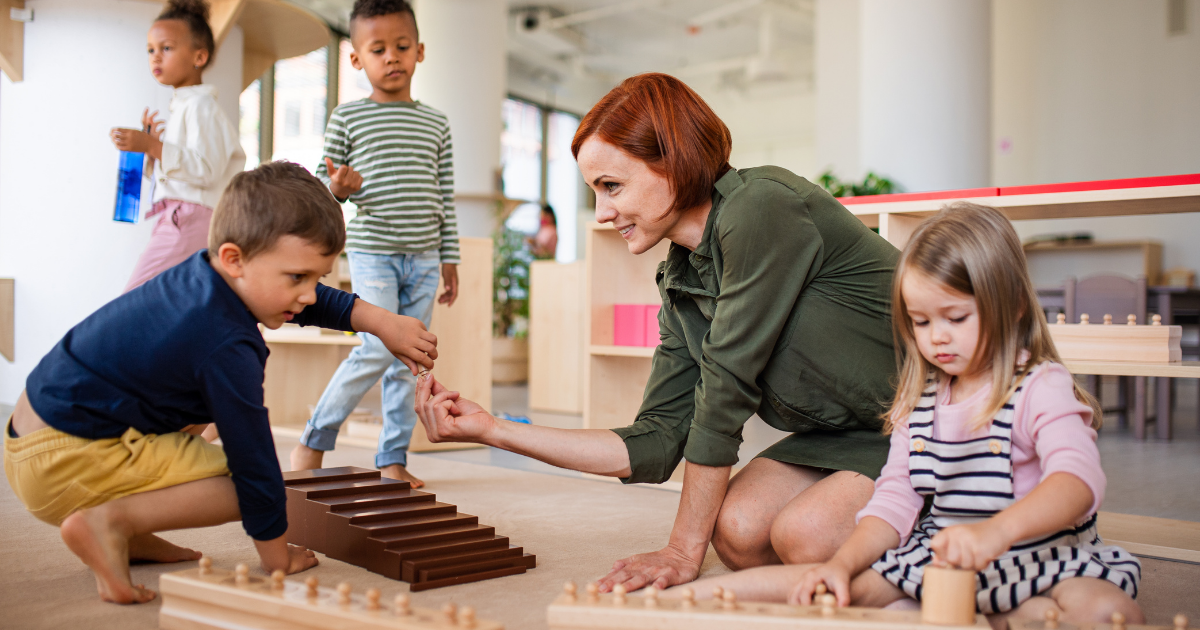
Choosing the right early education for a child is one of the most important decisions a family will make. Among the many philosophies available, Montessori and Reggio Emilia stand out for their child-centered approaches, emphasizing independence, curiosity, and hands-on learning. While both share similar values, they differ in classroom structure, teaching strategies, and daily routines. Exploring Reggio Emilia vs. Montessori schools can help parents understand how each approach works and which one best supports their child’s growth. Let’s take a closer look at each one.
Understanding the Montessori Approach
Developed by Dr. Maria Montessori over a century ago, the Montessori method is built on the idea that children learn best when they can explore and discover at their own pace. Montessori classrooms are carefully organized, providing children with opportunities to engage in meaningful, purposeful activities. Rather than following a rigid curriculum, children are encouraged to take the initiative in their learning, promoting independence, confidence, and critical thinking.
Core principles of Montessori education include:
- Child-led exploration: Children choose from a selection of carefully prepared activities, allowing them to follow their natural interests and develop a sense of autonomy.
- Focused work periods: Extended blocks of uninterrupted time help children concentrate, explore deeply, and complete tasks without unnecessary distractions.
- Hands-on learning: Manipulatives and practical materials provide tactile, experiential learning opportunities, letting children understand concepts through direct interaction.
- Mixed-age learning: Classrooms often include children spanning several years, fostering peer mentoring and collaborative learning while allowing younger children to observe and learn from older peers.
Benefits of Montessori Education:
- Encourages self-reliance and decision-making skills
- Builds concentration and perseverance
- Supports emotional and social development
- Develops practical life and problem-solving skills
This approach works well for children who thrive in a structured yet flexible environment, enjoy hands-on activities, and benefit from working at their own pace. Families seeking a balanced education that emphasizes both personal independence and academic readiness often find Montessori a strong match.
Understanding the Reggio Emilia Approach
Originating in the Italian city of Reggio Emilia after World War II, the Reggio Emilia philosophy views children as capable, curious, and full of potential. First developed under the leadership of educator Loris Malaguzzi, the approach quickly gained recognition for its innovative, community-driven vision of early childhood education. It emphasizes learning as a collaborative, dynamic process in which teachers observe and listen closely to each child, using their interests as the foundation for projects and exploration. Classrooms are designed to be inspiring spaces that encourage creativity, inquiry, and expression, often incorporating art, natural materials, and real-world experiences.
Core principles of a Reggio Emilia education include:
- Emergent learning: Education is guided by children’s questions and interests rather than a fixed curriculum, allowing learning to grow naturally.
- Project-based exploration: Activities and projects evolve from observation and interaction, giving children opportunities to investigate topics deeply and creatively.
- Collaboration and relationships: Emphasis is placed on cooperation among children, teachers, and families, fostering strong social skills and a sense of belonging.
- Reflective learning environment: Classrooms are thoughtfully arranged to encourage observation, discussion, and exploration, making the environment an active participant in education.
Benefits of Reggio Emilia Education:
- Enhances creativity and imagination
- Promotes collaboration and teamwork
- Encourages critical thinking and problem-solving
- Supports individualized learning based on each child’s interests
When exploring between Reggio Emilia vs. Montessori schools, parents should note that a Reggio Emilia approach is ideal for children who enjoy interactive, collaborative learning and thrive in a flexible, stimulating environment. Families who value creativity, curiosity-driven education, and strong community engagement often find Reggio Emilia to be a great fit.
Comparing Montessori and Reggio Emilia
While both philosophies prioritize child-centered learning, their approaches are distinct. Montessori offers structure, independence, and clear pathways for skill-building by providing carefully prepared environments where each material builds on previously mastered concepts. Lessons are sequenced to move from simple to complex, allowing children to progress at their own pace while developing confidence and discipline. The emphasis on order, routine, and self-directed activity helps children strengthen concentration and build skills step by step, creating a strong foundation for both academic and practical learning.
Reggio Emilia, on the other hand, provides flexibility, encourages creativity, and emphasizes collaboration, allowing children to shape their own learning experiences in response to their curiosity. Many parents are drawn to this approach because they feel it nurtures imagination, adaptability, and strong communication skills, qualities they see as increasingly important in today’s world. Both methods, however, share common values: they respect children as active learners, emphasize hands-on experiences, and promote social, emotional, and intellectual growth. Many modern schools even integrate elements of both philosophies, creating hybrid environments that provide the benefits of structure and creativity simultaneously.
When deciding between these approaches, families should consider:
- Child’s learning style: Does the child prefer independence and structured tasks, or collaboration and exploration?
- Family values: Are you looking for practical skill-building and self-reliance, or flexibility, creativity, and community-focused learning?
- School environment: How does the classroom design, teacher role, and daily routine align with your child’s personality and needs?
There is no single “best” approach, what matters most is finding a learning environment that supports your child’s growth, curiosity, and confidence. When comparing Reggio Emilia vs. Montessori schools, both philosophies share a commitment to cultivating well-rounded, capable, and inquisitive children. Research shows that children who attend Montessori preschools often outperform peers in both academic achievement and socio-emotional development. Likewise, evaluations of the Reggio Emilia approach indicate that children in Reggio-inspired programs demonstrate strong school adjustment over time. These findings suggest that either approach can provide a powerful foundation for personal growth, preparing children to thrive academically, socially, and emotionally in the years ahead. By understanding each philosophy and considering the benefits, parents can make an informed choice that nurtures their child’s natural strengths and interests.
